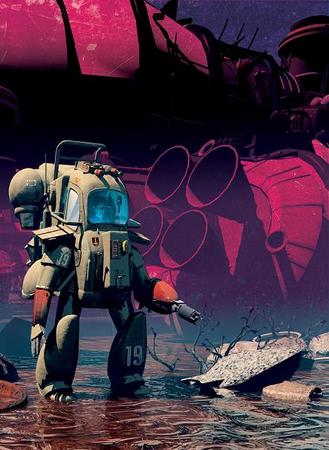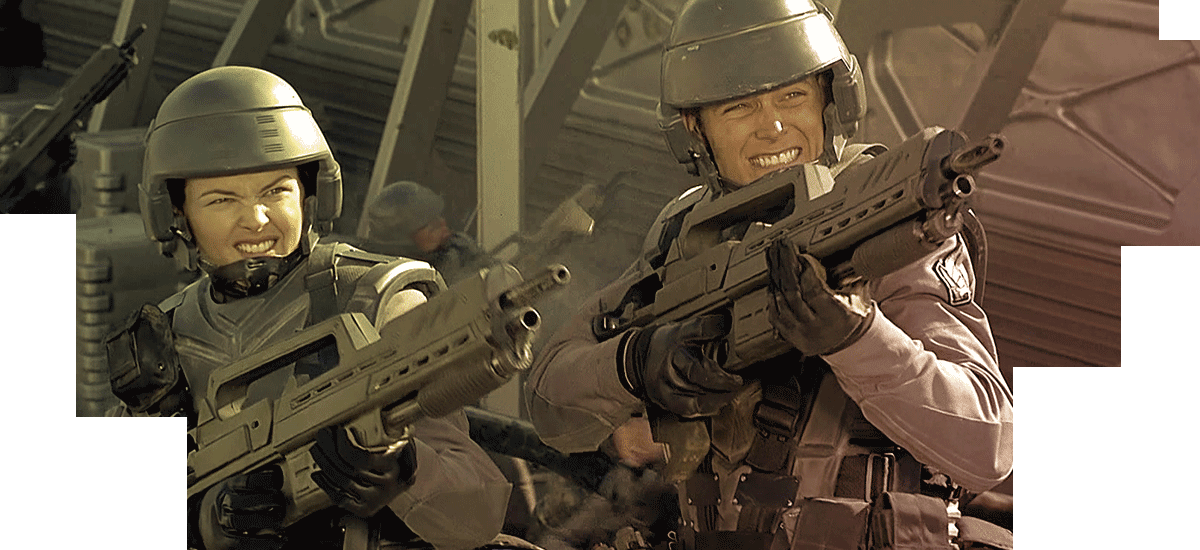Starship Troopers (1997) concept art
Tag: starship troopers
28 Days of Sci-February #18
28 Days of Sci-February #1
The Forever War Italian book cover
Direct Beam Comms #100
TV
S.W.A.T.
My familiarity with the S.W.A.T. franchise is relatively limited. I saw, and remember liking the 2003 feature film that starred Colin Farrell, Samuel L. Jackson and Jeremy Renner about a Los Angeles S.W.A.T. team who has to transport a drug kingpin across the city where every bad guy in town wants to set him free. But I’ve never seen the 1970s TV series that movie was based on nor the follow-up S.W.A.T. movies either.
Still, I went into the new CBS S.W.A.T. series with an open mind as I try to do with everything I watch.
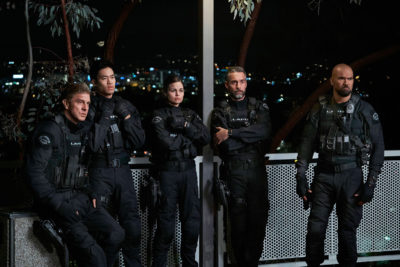 Starring a scowling/frowning Shemar Moore – TV’s Vin Diesel – as Daniel ‘Hondo’ Harrelson, this new S.W.A.T. takes place in a very modern LA where police offers are often judged by decisions they have to make in an instant. Which, because of the sensitivity of the issues being tackled in S.W.A.T like police shooting unarmed civilians needs to be handled with a delicate touch. Of which S.W.A.T. approaches with the delicate touch of a sledge hammer.
Starring a scowling/frowning Shemar Moore – TV’s Vin Diesel – as Daniel ‘Hondo’ Harrelson, this new S.W.A.T. takes place in a very modern LA where police offers are often judged by decisions they have to make in an instant. Which, because of the sensitivity of the issues being tackled in S.W.A.T like police shooting unarmed civilians needs to be handled with a delicate touch. Of which S.W.A.T. approaches with the delicate touch of a sledge hammer.
The Los Angeles of S.W.A.T. is a crazy, hyperkinetic city where the criminals battle it out with police using machine guns and RPGs while the S.W.A.T. Officers, who sometimes seem like the only police in the city, must deal with said RPGs one day and police involved shooting protestors the next. Things are about to boil over to riots when Hondo decides to treat the people “like family” and everything’s okay which allows them to go after the real machine-gun toting bad guys.
S.W.A.T. is a sort of cross between the police TV procedural and The Fast and the Furious movies where when the S.W.A.T. team aren’t involved in firefights, climbing on roofs or riding to work on motorcycles going 100 miles per hour they’re making out with their girlfriends who look like gorgeous models.
What I liked about S.W.A.T. didn’t involve the story. Some of the photography in the series was gorgeous, especially the stuff that was shot at night. It didn’t look like the typical stuff shot at night that turns up on TV. This was different. It was less about setting up lights to shoot everything than it was about using the cameras to capture the weird qualities of what it’s really like to be outside in a city at night. Where some things are in the shadows and some are not with the sky casting a weird glow.
Side-note — S.W.A.T. has to be the show with the most amount of people climbing on roofs I’ve ever seen. I don’t mean people already on roofs, I mean people climbing from the ground over things to get onto roofs. At least twice in the show cops and bad guys start off on the ground, climb up fences and onto roofs to run across roofs to jump down to the other side. I don’t know why I noticed this? Maybe the first time they did it was neat, but the second time I kind’a wondered if they were running out of ideas.
Things TV lovers don’t have to worry about today that fans of the past did
I was thinking the other week about all the rigmarole fans of TV, myself included, used to have to go through to watch their favorite shows. Even just a few years ago before the advent of streaming services and a decade or so back before the ubiquitousness of the DVR it could be a pain to watch your favorite series if it aired at an odd time or alongside something else you wanted to watch even more. So I decided to put together a list of things I used to have to worry/think about when I wanted to watch my favorites shows.
- You generally needed to make an appointment to watch TV. If what you wanted to see was on at 8 on Monday, you needed to be in front of the TV at 8 on Monday to watch it.
- And you usually turned over early to watch your show. So if you wanted to see, say, Space Rangers on CBS you might turn over a little early and catch the tail-end of Major Dad every week whether you were a fan of Gerald McRaney or not.
- Sometimes you had to stay up late or, like I did to watch the series Robotech, get up early to catch a show.
- I never did this myself, but I’ve heard of people setting alarms in the middle of the night in order to get up to watch a certain movie they’d always wanted to see or hadn’t seen in years.
- You sometimes had to tape over some program you’ve already watched but maybe wanted to keep for future viewings in order to record something new if you didn’t have, or couldn’t afford, a new tape.
- Having to budget money for tapes when a pack of them cost $20.
- If you missed an episode of a particular program you seriously didn’t know if you’d ever see it again.
- You sometimes had to pick one show over another if they happened to air opposite one and other. You’d pray that the show you didn’t watch survived long enough for repeats of it to air over the summer when TV networks re-ran all their series. Otherwise you might never see that series again.
- Waiting for your favorite show to start Sunday nights when football was running long and seeing and hearing the dreaded, “We join your program already in progress,” message and just having to accept that you’ve missed the first however many minutes football ate into your favorite show and spending the episode trying to play catchup with what’s going on.
Movies
Starship Troopers
 Over the years I’ve written a lot about the movie Starship Troopers. Probably too much for a movie that upon its release was denounced by most and quickly forgotten. Over the years there has been a bit of appreciation for Starship Troopers develop, but not as much as I’d thought there would’ve been when I saw it 20 years ago.
Over the years I’ve written a lot about the movie Starship Troopers. Probably too much for a movie that upon its release was denounced by most and quickly forgotten. Over the years there has been a bit of appreciation for Starship Troopers develop, but not as much as I’d thought there would’ve been when I saw it 20 years ago.
Still, I can’t deny how much I adore Starship Troopers or how much I love watching it even today. So here are a few links to articles I’ve written over the years about Starship Troopers.
- 1998: Controversy and Dead Bugs, a Great Combination
- 2007: Starship Troopers: A Primer
- 2012: 15 Years of Starship Troopers
The Reading & Watch List
- The Hand-Drawn Journey of the ‘Shape of Water’ Poster
- ‘X-Men’ at 25: The Unlikely Story of the Animated Hit No Network Wanted
- Why 2017’s Hit Horror Movies Are Just the Beginning of the Revived Genre
- ‘Twilight Zone’ Reboot From Jordan Peele in the Works at CBS All Access
- ‘Big void’ identified in Khufu’s Great Pyramid at Giza
- Why Movie-Ticket Surge Pricing Is a Bad Idea
- The underground story of Cobra, the 1980s’ illicit handmade computer
- This Is How North Korea Smuggled In 87 U.S. Scout Helicopters
This week in pop-culture history
- 1932: Roy Scheider of JAWS and SeaQuest DSV is born
- 1949: Armin Shimerman, Buffy the Vampire Slayer and Quark of Star Trek: Deep Space Nine is born
- 1964: Robert Duncan McNeill, Tom Paris of Star Trek: Voyager is born
- 1969: Marooned premiers
- 1970: Ethan Hawke of Explorers and Gattaca is born
- 1973: Radha Mitchell, Fry of Pitch Black is born
- 1975: The TV series The New Adventures of Wonder Woman debuts
- 1993: RoboCop 3 opens in theaters
- 1994: The TV series Earth 2 premiers
- 1997: Starship Troopers premiers
1990s sci-fi movie bonanza
There was an explosion of sci-fi movies all released in the late 1990s because Jurassic Park and Independence Day had come out earlier in the decade and were colossal hits. The movie studios, wanting a piece of the sci-fi money pie like how now they all want a slice of the superhero one, started putting money behind sci-fi films. And because of this money and since computer 3D special effects could now make sci-fi things like aliens and spaceships look real meant that not only could sci-fi movies have interesting stories, they could look really cool too.
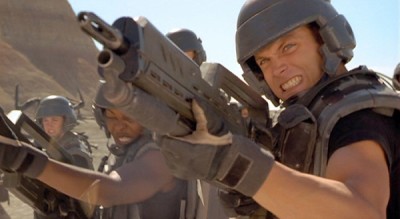
Unfortunately, none of these late–1990 sci-fi movies were successful — until one huge film in 1999 that would change the sci-fi landscape even to this day.
Let’s start with my favorite sci-fi film of this period that turns 20 this fall, Starship Troopers. This movie about a team of teen military troopers doing battle with giant bugs on far off planets never got the attention it deserved. Or really, it got attention but the bad kind. I think the reason this movie was so derided was that audiences didn’t know what to make of it at back then. Here’s my secret for watching Starship Troopers — don’t think of it as a movie from 1997, think of it as a movie from 2197 that accidentally got transported to present day. To me, Starship Troopers is this propaganda film from the future trying to get the population behind this costly, unending war with the bugs and I think watching the movie in that light makes for a more enjoyable experience.

Even Horizon, also from 1997, is another movie that was derided by the critics back then but is seen in a better light today. This R-Rated horror movie about the crew of a ship sent to Neptune to rescue the survivors of the “Event Horizon” that disappeared years ago and but finds the ship possessed by some evil force is a lot of fun to watch. Event Horizon isn’t the greatest movie, but it’s not a bad one either.
Another film from 1997 that didn’t do well at the time though now is seen in a better light is The Fifth Element. This one doesn’t fit with any other US based sci-fi movies and feels totally different, but in a good way. Much of that’s because it was co-written and directed by Frenchman Luc Besson. Here, forces are trying to unleash a great evil upon the universe and it’s up to Korben Dallas (Bruce Willis) and Leeloo (Milla Jovovich) to stop them. At times The Fifth Element is a bit goofy and weird but that’s not necessarily a bad thing. Over the years The Fifth Element has aged very well and is a visually stunning and quite good movie.

Lost in Space from 1998 on the other hand, hasn’t aged very well and isn’t a good movie. This big-screen remake of the 1960s TV classic starts off interestingly enough with a family of explorers blasting off into an unknown part of space and after an accident and must find their way home. But the second half of the movie never quite fully gels and feels underdone. Worst of all some of the special effects of Lost in Space today look clunky and stand out in a bad way.
Like with Lost in Space the movie Soldier from 1998 hasn’t stood the test of time. Or, I thought it was a bad movie back in 1998 and I think it’s still a bad movie in 2017. Soldier is about an old solider from the future played by Kurt Russell who’s replaced by a newer model and is dumped on a world of trash where he finds a new calling of protecting families marooned there. Soldier is a movie that looks cheap and flimsy with a story to match. Let’s put it this way, the best part of the trailer for Solider features scenes of a giant battle and a skeleton floating in space — none of which appears in the finished film.
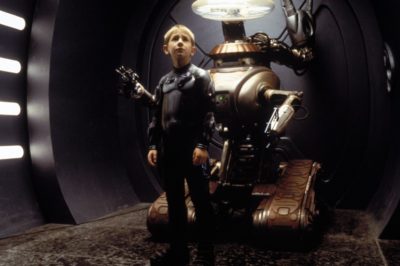
Why anyone would leave the best looking part out of a movie like that is beyond me, but it goes a long way in explaining why Solider is the way it is.
In fact, it wasn’t until the stealth sci-fi film The Matrix would come along in 1999 to both critical acclaim and find a box office bonanza that would change the sci-fi game for the next decade. Gone would be the spaceships and far-off planets of previous decades instead replaced with a more dark and run-down aesthetic with films like Pitch Black, Minority Report and many of the early superhero films of the early 2000s borrowing the style of The Matrix.


